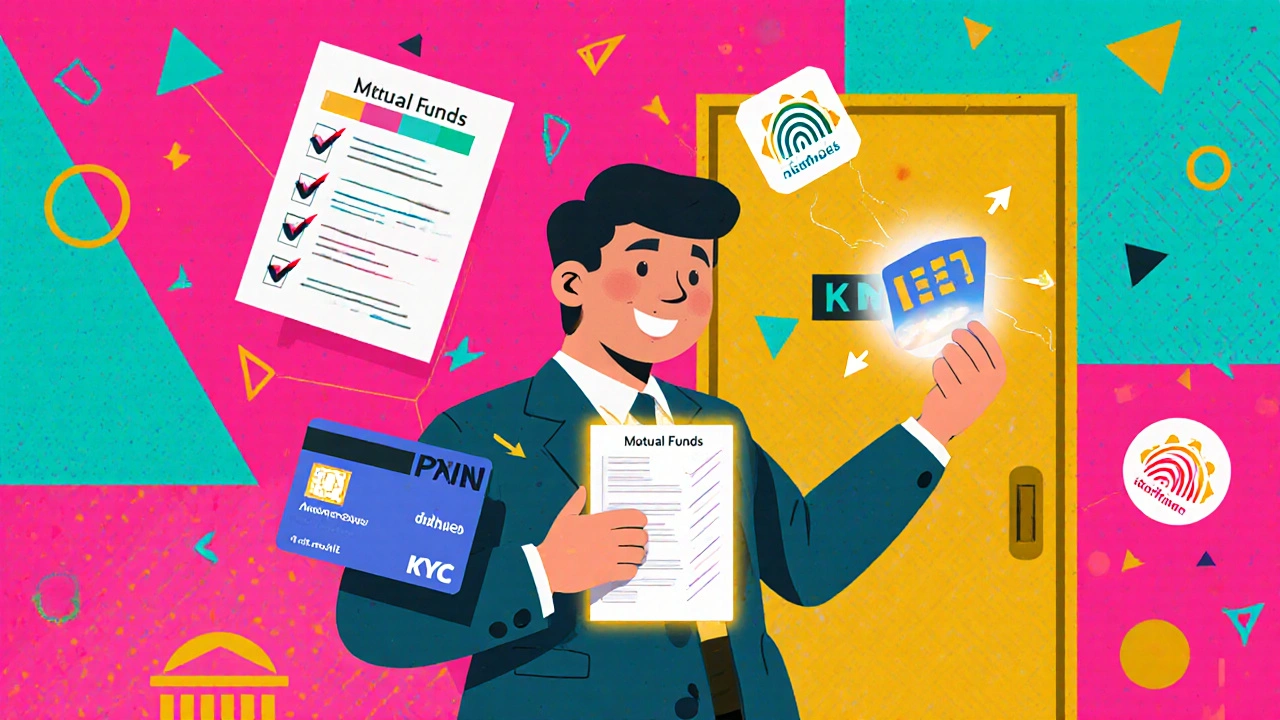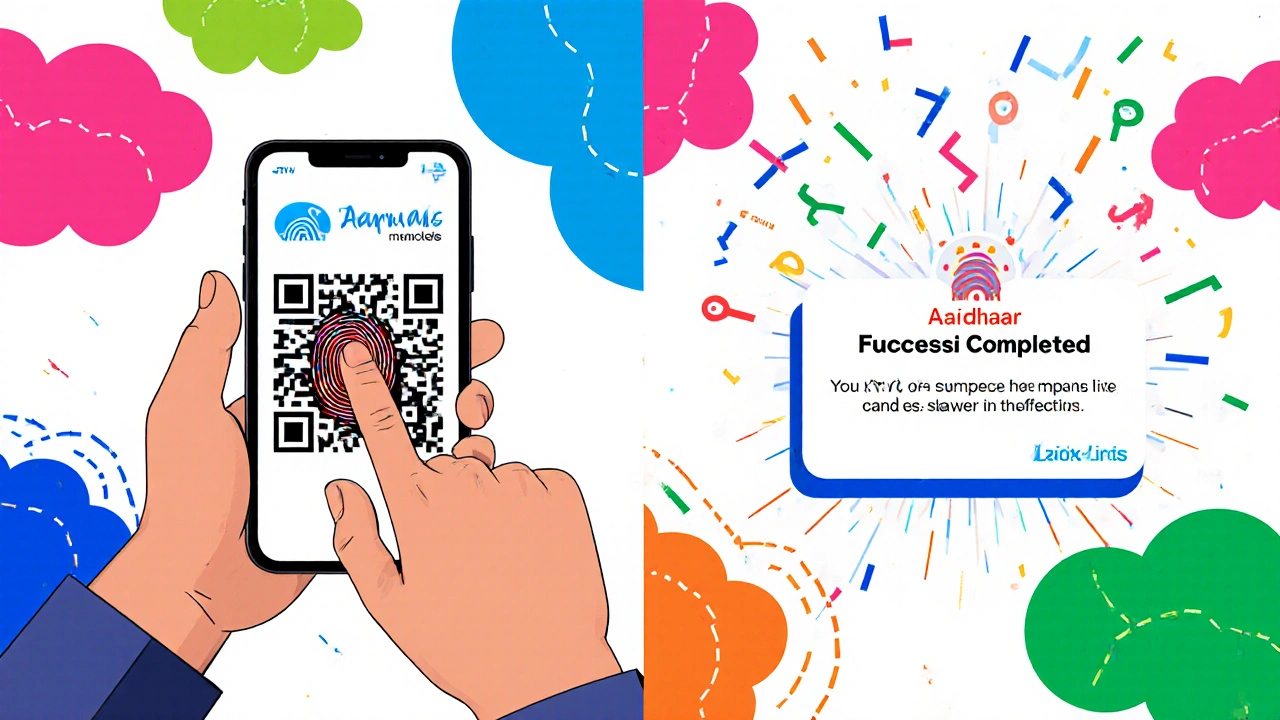How to Use KYC, PAN, and Aadhaar for Investing in Mutual Funds in India
 Nov, 16 2025
Nov, 16 2025
Want to start investing in mutual funds in India but stuck on paperwork? You’re not alone. Thousands of new investors hit the same wall: KYC, PAN, and Aadhaar. It sounds like a maze of acronyms, but it’s actually simple once you know the steps. These three documents aren’t just formalities-they’re the legal backbone of every mutual fund investment in India. Skip them, and you can’t buy a single unit. Get them right, and you open the door to long-term wealth building.
Why KYC, PAN, and Aadhaar Are Non-Negotiable
The Securities and Exchange Board of India (SEBI) made KYC (Know Your Customer) mandatory for all mutual fund investors back in 2012. The goal? To stop money laundering and make sure only real people are investing. PAN (Permanent Account Number) is your tax ID. Aadhaar is your 12-digit biometric identity. Together, they form a trusted trio that links your identity, tax status, and bank account.
No PAN? No mutual fund account. No Aadhaar? Your KYC won’t complete. No KYC? Your money won’t move. It’s that direct. Even if you’re investing through an app like Groww or Zerodha, these three documents are checked before your first rupee is invested.
What Is KYC in Mutual Funds?
KYC stands for Know Your Customer. In mutual funds, it’s not just a form you fill once-it’s a verification process that confirms who you are, where you live, and that you’re legally allowed to invest. Once you complete it, you’re KYC-compliant across all fund houses. You don’t need to do it again for SBI Mutual Fund, HDFC, or ICICI Prudential.
There are two types of KYC: in-person and e-KYC. In-person KYC means visiting a point of service (like a bank branch or CAMS/Karvy office) with your original documents. e-KYC is faster and done online using your Aadhaar number and biometrics. Most people today use e-KYC because it takes under 10 minutes.
PAN Card: Your Tax Identity for Investments
You can’t invest in mutual funds without a PAN card. It’s issued by the Income Tax Department and links all your financial transactions to your tax profile. When you buy mutual funds, the fund house reports your gains and dividends to the tax department using your PAN.
If you don’t have a PAN, you can apply online at the NSDL or UTIITSL website. The process takes 7-10 days. You’ll need your Aadhaar, a photo, and proof of address. Once approved, you’ll get a physical card and a digital copy. Keep both handy.
Important: If you’re under 18, your guardian’s PAN is used. If you’re a Non-Resident Indian (NRI), you still need a PAN-but your KYC process is slightly different.
Aadhaar: The Digital Key to e-KYC
Aadhaar is India’s universal identity system. For mutual fund investing, it’s the shortcut to instant KYC. When you link your Aadhaar to your bank account and mutual fund folio, you can complete KYC in minutes using your fingerprint or OTP.
But here’s the catch: your Aadhaar must be updated. If your mobile number or address is outdated, e-KYC will fail. Check your Aadhaar status at uidai.gov.in. If your details are wrong, update them before starting KYC.
Also, make sure your Aadhaar is linked to your bank account. Most fund houses auto-validate your bank details using Aadhaar. If they can’t match your bank account to your Aadhaar, your investment will be rejected-even if your PAN and KYC are fine.

Step-by-Step: How to Complete KYC Using PAN and Aadhaar
Here’s how to do it right, step by step:
- Make sure you have a valid PAN card. If you don’t, apply for one at nsdl.com or utsl.com.
- Confirm your Aadhaar details are current. Update your mobile number and address if needed.
- Link your Aadhaar to your bank account. Do this via net banking or by visiting your branch.
- Open a mutual fund account through an app (Groww, Coin by Zerodha, Paytm Money) or a distributor.
- When prompted, choose e-KYC and enter your Aadhaar number.
- Enter the OTP sent to your Aadhaar-linked mobile number.
- Complete biometric verification if asked (fingerprint scan via your phone’s camera or a registered device).
- Upload a clear selfie as proof of identity.
- Your KYC status will show as ‘Completed’ within 2-5 minutes.
That’s it. You’re now KYC-compliant. You can start investing in any mutual fund scheme in India.
Common Mistakes That Block Your Investment
People get stuck for days because of simple errors. Here are the top three:
- Using an old mobile number-If your Aadhaar mobile is outdated, you won’t get the OTP. Update it at the nearest Aadhaar center.
- Not linking Aadhaar to bank-Your bank account must be Aadhaar-enabled. If it’s not, your fund house can’t verify your identity.
- Uploading blurry documents-A fuzzy PAN card or dark selfie gets rejected. Use natural light and a plain background.
Another mistake: thinking you only need to do KYC once. If your address changes, you must update your KYC. If your name changes (after marriage, for example), you need to re-KYC with proof.
What Happens After KYC Is Done?
Once your KYC, PAN, and Aadhaar are verified, you can:
- Invest in any mutual fund scheme-equity, debt, hybrid, or index funds.
- Start SIPs (Systematic Investment Plans) with as little as ₹500/month.
- Switch between funds without redoing KYC.
- Redeem units anytime, with payouts going directly to your Aadhaar-linked bank account.
Your investments are tracked under your folio number, which is tied to your PAN. You’ll get monthly statements via email or through the fund house app. All tax documents (like Form 16A for dividends) are generated using your PAN.
Can You Invest Without Aadhaar?
Technically, yes-but it’s messy. If you don’t have Aadhaar, you can still do in-person KYC. Visit a CAMS or Karvy office with your PAN, address proof (like a utility bill), and photo ID (driver’s license or passport). They’ll verify your documents manually and submit your KYC.
But here’s the problem: manual KYC takes 7-10 business days. e-KYC is instant. Also, many apps don’t even offer in-person KYC anymore. If you’re starting fresh in 2025, Aadhaar is the only practical path.

How to Check Your KYC Status
Want to know if you’re already KYC-compliant? Here’s how:
- Go to kra.gov.in (KYC Registration Agency).
- Click on ‘Check KYC Status’.
- Enter your PAN number.
- Click ‘Submit’.
You’ll see your status: ‘Verified’, ‘Pending’, or ‘Rejected’. If it says ‘Verified’, you’re good to invest. If it’s pending, check your Aadhaar linkage. If rejected, find out why-usually it’s mismatched name or address.
What If Your KYC Gets Rejected?
Don’t panic. Rejection usually happens because of mismatched data. Common reasons:
- Your name on PAN doesn’t match your Aadhaar (e.g., ‘Raj Kumar’ vs. ‘Raj K.’).
- Your address on Aadhaar is different from your bank’s records.
- Your photo is too dark or you’re wearing glasses in the selfie.
To fix it:
- Log into your mutual fund app or website.
- Go to ‘KYC Status’ or ‘Profile’.
- Click ‘Re-submit’ or ‘Update’.
- Upload corrected documents.
- Retry e-KYC with a clear selfie and correct OTP.
If you’re still stuck, contact the fund house’s customer support. Most have a dedicated KYC helpline.
Security Tips: Protect Your Documents
Your PAN and Aadhaar are sensitive. Never share them over WhatsApp or email unless it’s a verified platform. Always use official apps or websites. Look for the padlock icon in your browser and check the URL.
Also, avoid using public Wi-Fi when uploading documents. Use your home network or mobile data. Once your KYC is done, delete any saved copies of your documents from your phone unless you need them for tax filing.
Next Steps: Start Investing
Now that your KYC, PAN, and Aadhaar are sorted, what should you invest in?
- Start with a balanced fund if you’re new-something like Axis Balanced Advantage or ICICI Prudential Balanced Advantage.
- Set up a monthly SIP of ₹1,000-₹5,000. Consistency beats timing the market.
- Use the ‘Direct Plan’ option. It has lower fees than regular plans.
- Review your portfolio once a year. Don’t chase trends.
Remember: mutual funds are for the long term. Don’t expect quick returns. But with KYC done right, you’re on the path to building real wealth.
Do I need to do KYC again if I switch fund houses?
No. Once your KYC is completed through any registered agency like CAMS or Karvy, it’s valid across all mutual fund houses in India. You don’t need to repeat the process if you switch from HDFC to SBI Mutual Fund or vice versa.
Can I invest in mutual funds without a PAN card?
No. A PAN card is mandatory for all mutual fund investments in India, as per SEBI rules. Without a PAN, your application will be rejected, even if your KYC and Aadhaar are complete.
Is e-KYC safe to use for mutual funds?
Yes, e-KYC is secure and approved by SEBI. It uses encrypted OTPs and biometric verification linked to your Aadhaar. Only registered platforms like CAMS, Karvy, or apps tied to AMFI-registered distributors offer e-KYC. Avoid third-party websites asking for your Aadhaar details directly.
What if my Aadhaar and PAN names don’t match exactly?
Your names must match exactly. If your PAN says ‘Amit Singh’ and your Aadhaar says ‘Amit Kumar Singh’, your KYC will fail. You’ll need to update one of the documents-either your PAN or Aadhaar-at the official portals. Minor spelling errors or missing middle names can cause rejection.
Can NRIs use Aadhaar for mutual fund KYC?
No. NRIs cannot use Aadhaar for KYC because it’s only issued to Indian residents. NRIs must complete in-person KYC using their passport, visa, overseas address proof, and PAN. Some fund houses allow e-KYC via video verification for NRIs, but Aadhaar is not accepted.
